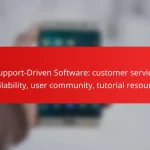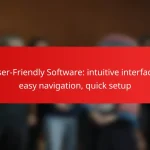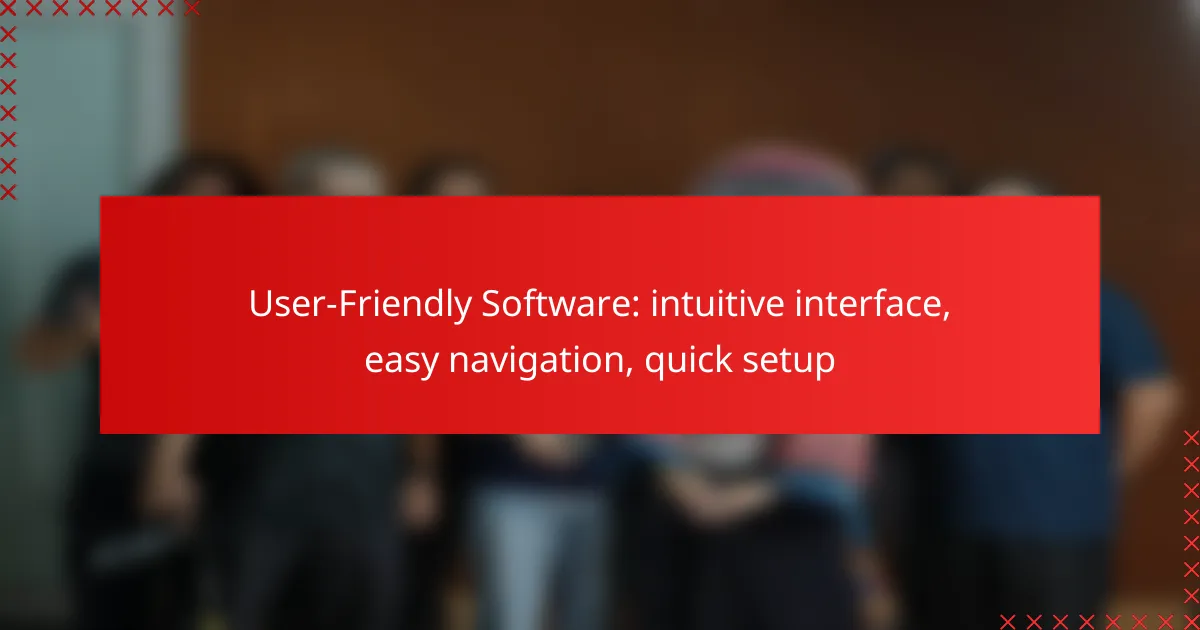User-friendly software is characterized by its intuitive interface, easy navigation, and quick setup, making it accessible for users of all skill levels. With a focus on minimizing confusion, these tools allow individuals to engage with the application effortlessly, enhancing overall productivity. Features like clear menu structures and effective search functionality further streamline the user experience, ensuring that essential tools and information are readily available.

What are the best user-friendly software options in the US?
Some of the best user-friendly software options in the US include Notion, Trello, Slack, Asana, and Monday.com. These tools are designed with intuitive interfaces, easy navigation, and quick setup processes, making them accessible for users of all skill levels.
Notion
Notion is a versatile workspace tool that combines note-taking, task management, and database functionalities. Its drag-and-drop interface allows users to easily create and organize content, making it suitable for both personal and team projects.
To get started with Notion, simply create an account and explore the templates available for various use cases. Users appreciate its flexibility, but it may take some time to fully harness its capabilities due to its extensive features.
Trello
Trello is a project management tool that uses boards, lists, and cards to help users visualize their tasks. Its straightforward layout makes it easy to navigate, allowing teams to track progress at a glance.
Setting up Trello is quick; users can create a board in minutes and start adding cards for tasks. While Trello is great for simple projects, larger teams might find it limiting without additional integrations.
Slack
Slack is a communication platform designed to facilitate team collaboration through channels, direct messaging, and file sharing. Its user-friendly interface allows for easy navigation between conversations and integrations with other tools.
Getting started with Slack involves creating a workspace and inviting team members. While it enhances communication, users should be mindful of notification overload, which can detract from productivity.
Asana
Asana is a task and project management software that helps teams organize work and track progress. Its clean interface and customizable dashboards make it easy to manage tasks and deadlines.
To use Asana effectively, create projects and assign tasks to team members. Users should take advantage of its timeline and calendar views to ensure deadlines are met, but they should avoid overcomplicating projects with too many tasks.
Monday.com
Monday.com is a work operating system that allows teams to manage projects and workflows visually. Its colorful interface and customizable templates make it user-friendly and engaging.
Setting up Monday.com is straightforward; users can choose from pre-built templates or create their own boards. However, teams should be cautious about adding too many columns or items, which can clutter the workspace and hinder usability.

How does intuitive interface improve user experience?
An intuitive interface significantly enhances user experience by making software easier to use and navigate. This design approach minimizes confusion, allowing users to quickly understand how to interact with the application without extensive training or guidance.
Reduces learning curve
An intuitive interface simplifies the process of learning new software, enabling users to grasp its functionalities quickly. By employing familiar design patterns and clear visual cues, users can often start using the software effectively within minutes, rather than hours or days.
For example, a well-designed dashboard with recognizable icons and straightforward navigation can allow users to perform essential tasks without needing extensive tutorials. This reduction in the learning curve is particularly beneficial in fast-paced environments where time is critical.
Enhances productivity
When users can navigate software easily, their productivity tends to increase. Intuitive interfaces streamline workflows by reducing the time spent searching for features or information, allowing users to focus on their tasks instead.
For instance, software that employs drag-and-drop functionality or customizable shortcuts can enable users to complete tasks more efficiently. This efficiency can lead to significant time savings, especially in collaborative settings where multiple users interact with the software simultaneously.
Increases user satisfaction
User satisfaction often correlates with the ease of use provided by an intuitive interface. When users find software enjoyable and straightforward to use, they are more likely to engage with it regularly and recommend it to others.
Feedback mechanisms, such as user surveys or ratings, can help developers understand how intuitive their interface is perceived to be. Addressing user concerns and continuously improving the interface can lead to higher satisfaction rates and foster long-term loyalty to the software.

What features contribute to easy navigation?
Easy navigation in software is primarily driven by a clear menu structure, effective search functionality, and customizable dashboards. These features enhance user experience by making it simpler to find and access necessary tools and information efficiently.
Clear menu structure
A clear menu structure organizes options logically, allowing users to locate features without confusion. Menus should be categorized intuitively, grouping related functionalities together to streamline access. For instance, a software application might separate tools for project management, reporting, and settings into distinct sections.
Consider using drop-down menus or sidebars that expand to reveal subcategories, which can reduce clutter and improve usability. Aim for a design that minimizes clicks while maximizing visibility of key features.
Search functionality
Robust search functionality allows users to quickly find specific items or features within the software. A search bar should be prominently placed and capable of handling various queries, including keywords, phrases, or even partial terms. This feature can save users significant time, especially in applications with extensive content or tools.
Implementing filters and advanced search options can further enhance usability, enabling users to narrow down results by categories or tags. Regularly updating the search algorithm based on user behavior can also improve accuracy and relevance.
Customizable dashboards
Customizable dashboards empower users to tailor their workspace according to personal preferences and workflow needs. Users should be able to add, remove, or rearrange widgets that display relevant information or tools, fostering a more personalized experience. For example, a project manager might prioritize task lists and deadlines on their dashboard.
Providing templates or pre-set configurations can help users get started quickly, while advanced customization options allow for deeper personalization. Ensure that changes are easy to implement and can be saved for future sessions to maintain efficiency.

How can quick setup benefit businesses?
Quick setup can significantly enhance business efficiency by reducing the time required to implement new software. This allows teams to start using the tools they need without lengthy delays, leading to faster adaptation and improved overall productivity.
Faster onboarding
Quick setup facilitates faster onboarding by minimizing the time new users spend learning how to use the software. With intuitive interfaces and streamlined processes, employees can become proficient in a matter of hours rather than days. This is especially beneficial for businesses with high turnover rates or seasonal hiring needs.
To ensure a smooth onboarding experience, consider providing clear documentation and video tutorials that guide users through initial setup steps. This can further accelerate their learning curve and reduce frustration.
Immediate productivity
When software can be set up quickly, employees can start working on their tasks almost immediately. This immediate access to necessary tools helps maintain momentum and prevents productivity lags that often occur during transitions. For example, a sales team can begin tracking leads and managing customer relationships right away.
To maximize immediate productivity, choose software that integrates seamlessly with existing systems. This reduces the need for additional configuration and allows employees to leverage familiar tools alongside new ones.
Lower training costs
Quick setup often leads to lower training costs, as less time is needed for formal training sessions. When software is user-friendly, employees can learn through exploration and hands-on experience, which is typically more effective than traditional training methods. This can save businesses significant amounts in training expenses.
To further reduce training costs, consider implementing a mentorship program where experienced users assist new employees. This peer-to-peer support can enhance learning while fostering a collaborative work environment.

What criteria should be considered when selecting user-friendly software?
When selecting user-friendly software, prioritize an intuitive interface, easy navigation, and quick setup. These criteria ensure that users can efficiently utilize the software without extensive training or frustration.
User reviews
User reviews provide valuable insights into the actual experiences of individuals using the software. Look for feedback that highlights the ease of use and any common issues faced during navigation or setup. High ratings often indicate a user-friendly design, while consistent complaints may signal potential pitfalls.
Consider checking multiple platforms for reviews, such as software comparison sites and forums. Pay attention to the context of the reviews to understand the specific needs and expectations of different user groups.
Integration capabilities
Integration capabilities are crucial for ensuring that the software works seamlessly with other tools and systems you already use. Look for software that offers APIs or built-in integrations with popular applications to streamline workflows. This can significantly enhance user experience by reducing the need for manual data entry or switching between platforms.
Evaluate the ease of integration by checking if the software provides clear documentation or support for setup. A user-friendly software should allow for quick connections with minimal technical knowledge required.
Customer support
Effective customer support is essential for resolving issues and enhancing user experience. Look for software that offers multiple support channels, such as live chat, email, and phone assistance. Quick response times and knowledgeable representatives can make a significant difference in user satisfaction.
Additionally, check if the software includes a comprehensive knowledge base or community forums. These resources can empower users to find solutions independently, further contributing to a user-friendly experience.

How do user-friendly software tools integrate with other platforms?
User-friendly software tools often integrate with other platforms through APIs, enabling seamless data exchange and functionality enhancement. This integration allows users to streamline workflows and improve efficiency by connecting various applications and services.
API availability
API availability is crucial for user-friendly software, as it determines how easily the software can connect with other tools and platforms. A well-documented API allows developers to access features and data, facilitating integration with third-party applications.
When evaluating software, check for API support and the types of integrations offered. Common integrations include CRM systems, payment gateways, and project management tools. Look for platforms that provide RESTful APIs, as they are widely adopted and easier to work with.
Consider the level of support and resources available for the API. Comprehensive documentation, sample code, and community forums can significantly ease the integration process. Additionally, ensure that the API has a stable version and is regularly updated to avoid compatibility issues.







